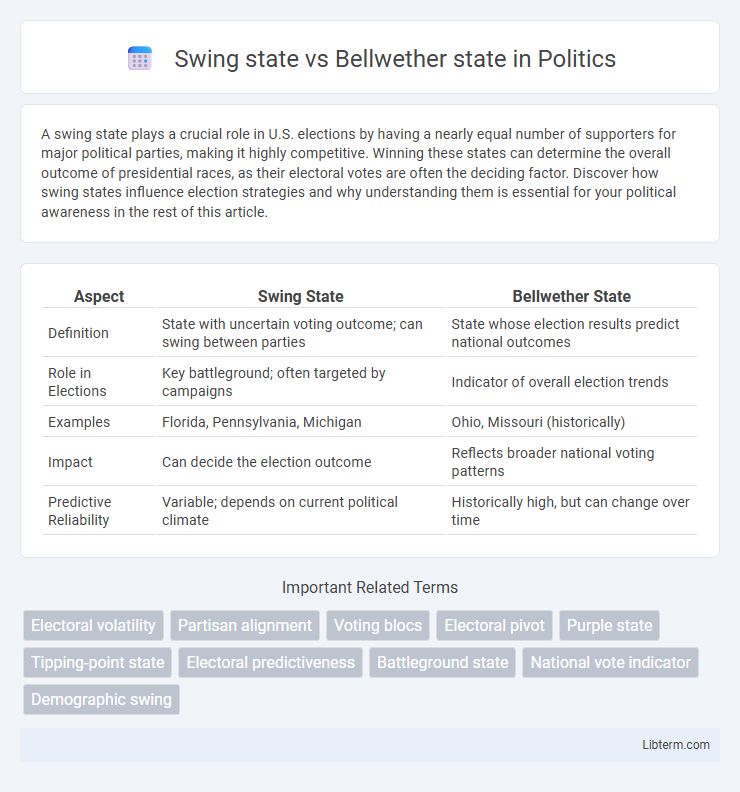A swing state plays a crucial role in U.S. elections by having a nearly equal number of supporters for major political parties, making it highly competitive. Winning these states can determine the overall outcome of presidential races, as their electoral votes are often the deciding factor. Discover how swing states influence election strategies and why understanding them is essential for your political awareness in the rest of this article.
Table of Comparison
| Aspect | Swing State | Bellwether State |
|---|---|---|
| Definition | State with uncertain voting outcome; can swing between parties | State whose election results predict national outcomes |
| Role in Elections | Key battleground; often targeted by campaigns | Indicator of overall election trends |
| Examples | Florida, Pennsylvania, Michigan | Ohio, Missouri (historically) |
| Impact | Can decide the election outcome | Reflects broader national voting patterns |
| Predictive Reliability | Variable; depends on current political climate | Historically high, but can change over time |
Introduction to Swing States and Bellwether States
Swing states, also known as battleground states, are U.S. states where both major political parties have similar levels of support, making them crucial in determining the outcome of presidential elections. Bellwether states are regions whose voting patterns historically align with the overall national election results, serving as indicators of the winner. Understanding the distinction between swing states and bellwether states is essential for analyzing election strategies and predicting electoral outcomes.
Defining Swing States: Key Characteristics
Swing states, also known as battleground states, are crucial in U.S. elections due to their unpredictable voting patterns and nearly equal support for major political parties. These states often have diverse demographics, fluctuating voter preferences, and a high number of undecided or independent voters, making them pivotal for campaign strategies. Key characteristics include narrow margins of victory in previous elections and their ability to influence the overall outcome of presidential races.
Understanding Bellwether States: What Sets Them Apart
Bellwether states consistently predict the overall outcome of national elections by mirroring the political preferences of the country as a whole, differing from swing states that are simply battlegrounds with fluctuating support. These states possess a demographic and socioeconomic diversity that aligns closely with the national electorate, making their voting behavior a strong indicator of broader electoral trends. Understanding bellwether states involves analyzing historical voting patterns and demographic shifts to recognize their unique predictive power in American politics.
Historical Examples of Notable Swing States
Ohio has historically been a crucial swing state, influencing multiple U.S. presidential elections due to its diverse electorate and economic significance. Florida serves as another prominent example, known for its decisive role in elections including the contentious 2000 presidential race. Pennsylvania also stands out for its impact in swing state dynamics, often reflecting national voting trends and tipping electoral outcomes.
Famous Bellwether States in U.S. Elections
Famous bellwether states in U.S. elections include Missouri and Ohio, both historically known for their accurate predictions of the overall presidential winner. Missouri aligned with the winning candidate in nearly every election from 1904 to 2004, while Ohio has matched the national outcome in most elections since 1944, making them key focus areas for political analysis. Swing states differ by fluctuating party support each cycle, but bellwether states consistently reflect national voting trends, emphasizing their unique role in forecasting election results.
Methodologies for Identifying Swing and Bellwether States
Analyzing voting patterns over multiple election cycles using statistical methods helps identify swing states by highlighting regions with closely contested outcomes and fluctuating party support. Bellwether states are determined through correlation analysis between state election results and national outcomes, revealing consistent alignment with overall election winners. Advanced data analytics, including demographic shifts and polling accuracy, further refine the methodologies in distinguishing these politically significant states.
Impact of Swing States on Presidential Elections
Swing states significantly influence presidential elections by hosting a large number of undecided voters whose preferences can shift campaign strategies and resource allocation. These states, including Florida, Pennsylvania, and Ohio, often determine the Electoral College outcome due to their variable voting patterns in closely contested races. Candidates invest heavily in advertising, rallies, and ground operations in swing states to secure crucial electoral votes that can tip the balance in national elections.
Predictive Power of Bellwether States
Bellwether states possess strong predictive power by consistently aligning with national election outcomes, making them key indicators of overall electoral trends. Unlike swing states, which are battlegrounds with fluctuating political loyalties, bellwether states reflect broader voter sentiment and demographic shifts that mirror the country's political landscape. Historical data reveal that states like Missouri and Ohio have accurately forecasted presidential winners, underscoring their significance in election forecasting models.
Challenges and Limitations of State Classifications
Swing states and bellwether states face challenges in classification due to shifting demographics and evolving political landscapes that may alter their predictive reliability in elections. The limitations of these state classifications stem from their historical dependency on past voting patterns, which may not account for emerging voter behavior trends or localized issues. Consequently, relying solely on these labels can lead to inaccurate electoral forecasts and strategic misallocations by political campaigns.
Future Trends: Are Swing and Bellwether States Still Relevant?
Swing states, characterized by their unpredictable voting patterns, continue to play a crucial role in determining U.S. presidential elections as demographic shifts and political polarization intensify competition. Bellwether states, historically reliable indicators of national election outcomes, face challenges due to changing political landscapes and regional realignments that may reduce their predictive accuracy. Future trends suggest that while swing states remain pivotal battlegrounds, the traditional bellwether model may evolve or diminish in relevance as electoral dynamics become more complex.
Swing state Infographic

 libterm.com
libterm.com